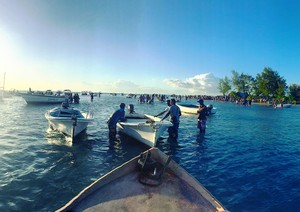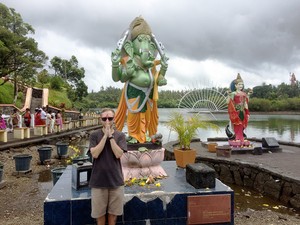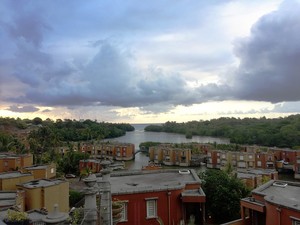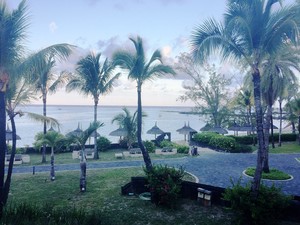Mauritius or Maurice in French, was my first experience with little islands in the Indian Ocean. You can find this tiny paradise about 1300 miles off the southeastern coast of Africa. Look for Madagascar on a map and then look about 700 miles to the right for Mauritius.
Here I had a friend I became close with while living in Australia. He was Mauritian who obtained his masters while studying abroad in Melbourne. He invited me to come stay with him and his family now that he was back in Mauritius.
Background History on Mauritius
Mauritius is a tiny island that is a huge holiday spot. You won’t find many backpackers here as they tend to only cater to resort crowds. The country itself is very multicultural and multireligious. Here you will find a mix of inhabitants that originate from Africa or India. Indo-Mauritian makes up the majority of the population and over 51% of Mauritian’s population are Hindus. As you drive along, you will see spirit houses in front of most houses or on the side of the road. Even Christians have their own shrines that look similar to the Hindu spirit houses here. On top of that, the locals speak French first, Creole with each other, and English if they need to. I found it amazingly unique the culture of Mauritius. One of the very few countries I did not witness any severe racism.
The Portuguese were the first Europeans to discover Mauritius but actually abandoned the island pretty quickly due to lack of interest. Next came the Dutch who named the island Mauritius after their current prince. After failing to produce an economy, the Dutch abandoned Mauritius as well. Next came the French who already claimed the neighboring island. The British eventually took over the island in the early 1800s and held the island until Mauritius became independent in 1968.
Parts of the Island
The north section of the island is the more touristy part. Grand Bay has become the largest tourist destination in Mauritius. Here you fill find more bars and clubs that are filled with tourists and locals. There are fewer resorts and more hotels up north so you will find a bit more of an active night scene. I also came to notice that the north part of Mauritius was a bit more expensive than the southern part.
Southern section – you will find the majority of the wild and beautiful landscapes here. The white sand and clear waters are at the bottom of mountains that overlook the rocky shores of Mauritius. Down here seems to be more relaxed and the majority of the ex-pat community resides.
Nature in Mauritus
Don’t let the size of this tiny island fool you. Mauritius is packed with hiking trails, a National Park, and exotic crystal clear beaches. The month I was there, I was able to experience some great outdoors Mauritius had to offer.
Flec en Flac
This was the area and beach my friend resided in. Known for being more of a locals beach, you can find tourists on certain sections. During the summer, you will find a lot of locals camping or practically living down there. The wooded areas before the beach are packed with canopies, tents, and tables of large groups ready to unwind for the weekend.
Black River Gorges National Park
Located in southwestern part of Mauritius, about 30 mins from where I was living, is Black River Gorges National Park. While in Mauritius it is imperative you rent a car for the day and venture out to this park. Go explore the lush mountains that are home to endangered plants and animals. You can view my more detailed guide here.
Seven Colored Earth
Seven Coloured Earths is an area of sand dunes that provide vibrant color displays. You can stop by on your way to/from Black River Gorges National Park.
Le Morne
The most famous summit in Mauritius for a good reason. The top of this mountain will display a stunning view of the western coast of Mauritius. View my guide to hiking Le Morne here.
Île aux Benitiers
The first week of January, a huge party goes down on the Île aux Benitiers island. This is a tiny island that is only accessible during high tide by boat. Right at the beginning of high tide, boats start shuttling people out there for a day time party.
The island is filled with hundreds of people during the entire high tide shift. Here a dancefloor + DJ booth is set up bumping music the whole time. Local vendors come over to try selling booze, local gifts, inflatables, food, or beverages. Other people will bring up their boat towards the coast and have their own mini parties.
The entire day is spent with a cold beer in your hand while enjoying the refreshing Île aux Benitiers island. It really is a great way to bring in the new year. I had a blast with the crew that invited me along.
The Local Spots
During the daytime, a lot of locals tend to go hang out at the closest mall. I found often we would go to eat at the food court for dinner. These are the places I was checked out while I was there. I mostly stuck to the southwestern side of is the island.
Hanging Out
- Lakaz Cascavalle – a locals club located 5 mins inland from Flic en Flac beach.
- Bush parties – the wealthier people of Mauritius like to host bush parties in their back yard and they do it properly. Out in the middle of nowhere, hundreds of people come to gather to dance under the stars till sunrise
- Backstage Lounge – Hennessey Park Hotel – a spot that does exotic fashion shows on weekends with house DJs
- Shots – a bar/club located in Flic en Flac. More touristy as it’s right on the beach road.
Munchies in Mauritius
- Flying Dodo – a brewpub of Mauritian craft beer.
- Vona Corona – an ice cream shop that has been around over 90+ years.
- Chelsea Cup N Cake – a coffee shop in Mauritius that is attempting to be hip and artsy. Feels a bit overdone and overprice, but it’s a nice change
- Delhi Taj Restaurant -some of the best Indian food I’ve ever had in my life
- Mauritian Boulettes stands – a food specifically found in Mauritius are their boulettes. Think dumplings in a broth. You can find them being sold by food trucks, stands, and restaurants alike.
- Dhal puri stands – very cheap meal that consists yellow split peas wrapped inside a roti flat bread along with some chilli.
Markets
- Rose Hill – known as more of the locals market and similar to a flea market. here you won’t nearly as much touristy items but household goods, clothes, and electronics.
- Quatre Bornes – Thursdays and Sundays are the textile market which is the one you want to go to. Not as touristy as the Port Louis market but you can find some souvenirs. Mostly you will find garments and clothes at a very reasonable price, even as a foreigner.
- Port Louis Central Market- the huge market located in the center of the capital. Here you will find a huge market that offers almost anything you could be looking for.
Misc. Things I Did
- Grand Bassin or Ganga Talao, a sacred lake found at about 1800 feet above sea level and just 2km east of Le Pétrin and one of the most important hindu pilgrimage sites outside of India.
- Fishing Trip
- Church at Cap Malheureux – the famous chapel that is on almost every Mautritiuan post card
- Citadel Fort Adelaide – an old British fort sitting on top of Port Louis
- Ambre Resort
- Albion Lighthouse – a lighthouse located on thw west coast. More importantly are the rock pools you can relax in right next to it.
Things I Learned
I firstly learned a lot about Hinduism as I have never visited a majority Hindu country. I was absolutely fascinated with the culture that comes with the religion. Every intricate and vibrant temple that matched the everyday style of clothes the locals wore.
I learned how to be polite in French. The month I was there, I learned how to hold a minor conversation and greet people.
How to stay calm after getting yourself lost on a local bus route in the middle of the villages.
To be more family oriented. In America, we make such a big deal of moving out and separating ourselves from our family. Then we get caught up in life and don’t make time for people we should be making time for. Come to find out, this is a very western thought process. In Mauritius, I learned that families stick together until you start a family of your own. Meaning, everyone lives together until you get married or start your own family or leave for school/work.






